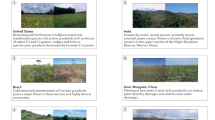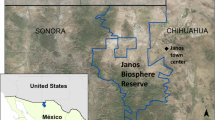Abstract
This chapter presents the importance of the Himalayan grasslands in terms of ecosystem services provided for both upstream and downstream people and the environmental problems associated with grassland degradation in the Himalayan region. Over half of the total area of the Himalayas support about 150 million people for their livelihood in the upstream regions, and three times as many people living in downstream regions with the important ecosystem services they provide. The sustainability of the Himalayan grasslands has significant impacts on both upstream and downstream populations. However, environmental degradation associated with human overexploitation and climate change has been challenging the sustainability of the Himalayan grasslands. Building on the case studies from grassland ecosystems and pastoral societies across the Himalayan countries, China, India, and Nepal, this chapter argues and illustrates that the indigenous knowledge and local institutions are critically important to promote the sustainable grassland management in the Himalayan region. The local pastoralists in the Himalayan region have developed adaptive strategies through social innovations to mitigate environmental challenges and socioeconomic pressures. Adjustment of grazing practice and grassland management is a key adaption strategy derived from evolving traditions of pastoral communities with environmental and social-economic changes.
Access this chapter
Tax calculation will be finalised at checkout
Purchases are for personal use only
Similar content being viewed by others
References
Alirol P (1979) Transhumaning animal husbandry systems in Kaligchowk Region (Central Nepal). Swiss Association for Technical Assistance/Integrated Hill Development Project, Kathmandu, Nepal
Cai H, Zhang XF, Dong SK, Jiang R, Shi YD, Zhao TR, Yang WJ, Shao JL (2013) A participatory survey on status and local pastoralists’ consciousness to animal husbandry in alpine grassland: a case study from Zhuaxixioulong Township of Tianzhu Tibetan Autonomous County, Gansu Province. Grassland Turf 33(2):66–72
Chan YN (2002) Livestock and rangeland management in Shangri-La Gorge, Shangri-La County, Northwest Yunnan, China. M.Sc. thesis, Lund University International Master’s Programme in Environmental Science, LUMES 2001/2002, Sweden
Chand SP, Gurung BD, Rood PG (1991) Farmers’ traditional wisdom: where does it stand within the present agricultural research systems of Nepal? Pakhribas Agricultural Centre (PAC) Occasional paper no. 4, Dhankuta, Nepal
Chapagain DP (1986) Managing public lands as a common property resources: a village case study in Nepal. Ph.D. thesis, University of Wisconsin, Madison, WI
Cornwall A, Pratt G (2004) Pathways to participation: reflections on participatory rural appraisal. Stylus Publishing, Sterling, VA
Dong SK, Sherman R (2015) Enhancing the resilience of coupled human and natural systems of alpine rangelands on the Qinghai-Tibetan Plateau. Rangeland J 37:i–iii
Dong SK, Lassoie JP, Yan ZL, Sharma E, Shrestha KK, Pariya D (2007) Indigenous rangeland resource management in the mountainous areas of northern Nepal: a case study from the Rasuwa District. Rangeland J 29:149–160
Dong SK, Lassoie J, Sherstha KK, Yan ZL, Sharma E, Pariya D (2009) Institutional development for sustainable rangeland resource and ecosystem management in mountainous areas of northern Nepal. J Environ Manage 90(2):994–1003
Dong SK, Wen L, Zhu L, Li XY (2010) Implication of coupled natural and human systems in sustainable rangeland ecosystem management in HKH region. Front Earth Sci China 4(1):42–50
Dong SK, Wen L, Yang ZF, Liu SL, Lassoie JP, Zhang XF, Yi SL, Li JP (2011) Vulnerability of worldwide pastoralism to global changes and interdisciplinary strategies for sustainable pastoralism. Ecol Soc 16(2):10, http://www.ecologyandsociety.org/vol16/iss2/art10/
Dong SK, Lassoie J, Wen L, Zhu L, Li XY, Li JP, Li YY (2012) Degradation of rangeland ecosystems in the developing world: tragedy of breaking coupled human-natural systems. Int J Sustainable Soc 4(4):357–371
Dutilly-Diane C, McCarthy N, Turkelboom F, Bruggeman A, Tiedemann J, Street K, Serra G (2007) Could payments for environmental services improve rangeland management in Central Asia, West Asia and North Africa? CGIAR system-wide program on collective action and property rights. CAPRI working paper no. 62
El-Ashry M (2009) Adaptation to climate change: building resilience and reducing vulnerability. Recommendations from the 2009 Brookings Blum Roundtable. United Nations Foundation. http://www.brookings.edu/~/media/Research/Files/Papers/2009/9/climate%20change%20poverty/09_climate_change_poverty_el_ashry.PDF
Farooquee NA, Saxena KG (1994) Adaptation, conservation and livestock management in high hills of central Himalaya: indigenous knowledge and practice. In: Somvanshi R, Lokeshwar RR (eds) Current advances in veterinary science and animal production in India. International Book Distribution, Lucknow, India, pp 123–129
Farooquee NA, Majila BS, Kala CP (2004) Indigenous knowledge systems and sustainable management of natural resources in a high altitude society in Kumaun Himalaya, India. J Hum Ecol 16:33–42
Gadgil M, Berkes F, Folke C (1993) Indigenous knowledge for biodiversity conservation. Ambio 22:151–156
Gibbs JN, Bromley DW (1989) Institutional arrangements for management of rural resources: common property regimes. In: Berkes F (ed) Common property resources: ecology and community-based sustainable development. Belhaven Press, London, pp 22–33
Gill GJ (1993) Indigenous system in agriculture and natural resource management: the policy dimension. In: Eds Tamang D, Gill GJ, Thapa GB (eds), Indigenous management of natural resources in Nepal Tamang. Proceeding of the Workshop on Indigenous Management of Agriculture and Natural Resources’. Dhulikhel, Nepal, 8–9 June 1992. pp. 3–12. (Winrock International: Kathmandu, Nepal.)
Gilmour DA (1990) Resource availability and indigenous forest management systems in Nepal. Soc Nat Resour 3:145–158
GOI (2007) Total area and classification of area in each district of Himachal Pradesh for the year 2006–2007. Directorate of Economics and Statistics, Ministry of Agriculture, Government of India
Harris RB (2010) Rangeland degradation on the Qinghai-Tibetan Plateau: a review of the evidence of its magnitude and causes. J Arid Environ 74:1–12
Lal JB, Gulati AK, Bist MS (1991) Satellite mapping of alpine pastures in the Himalayas. Int J Remote Sens 3:435–443
Land Resource Mapping Project (LRMP) (1986) Summary report of LRMP. His Majesty’s Government of Nepal and Government of Canada. Land Resource Mapping Project, Kathmandu, Nepal
Lee K (1993) Compass and gyroscope: integrating science and politics for the environment. Island Press, Washington, DC, 255 pp
Long RJ, Zhang DG, Wang X, Hu ZZ, Dong SK (1999) Effect of strategic feed supplementation on productive and reproductive performance in yak cows. Prev Vet Med 38:195–206
Long RJ, Ding LM, Shang ZH, Guo XH (2008) The yak grazing system on the Qinghai-Tibetan Plateau and its status. Rangeland J 30:241–246
Marshall G (2004) Economics for collaborative environmental management: renegotiating the commons. Earthscan Publications, London, UK
McCracken JA, Pretty JN, Conway GR (1988) An introduction to rapid rural appraisal for agricultural development. International Institute for Environment and Development, London
Meinzen-Dick R, Gregorio MD (2004) Collective action and property rights for sustainable development: overview. In: Meinzen-Dick R, Gregorio MD (eds) Collective action and property rights for sustainable development: 2020 vision for food, agriculture and environment. 2020 Focus II, Brief 1 of 16. International Food Policy Research Institute, Washington, DC, pp 1–2
Miles MB, Huberman AM (1994) Qualitative data analysis: an expanded sourcebook, 2nd edn. Sage, Thousand Oaks, CA
Miller DJ (1996) Pastoral development in the HKH: organising rangeland and livestock research for the twenty-first century. In: Chaudhry MA, Safdar A, Muhammad IA (eds) Proceedings of the seminar on farming systems research in the context of food security, Dera Ghazi Khan, Pakistan, 4–6 Aug 1996. University of Arid Agriculture, Rawalpindi, Pakistan
Ostrom E (1990) Governing the commons: the evolution of institutions for collective action. Cambridge University Press, London, UK
Patton MQ (1990) Qualitative evaluation and research methods, 2nd edn. Sage, Newbury Park, CA
Rai N, Thapa MB (1993) Indigenous pasture management systems in high-altitude Nepal: a review. HMG Ministry of Agriculture/Winrock International Policy Analysis in Agriculture and Related Resource Management, Research report series no. 22, Winrock International, Kathmandu, Nepal
Rawat GS (1998) Temperate and alpine grasslands of the Himalaya: ecology and conservation. Parks 8:27–36
Salant P, Dillman DA (1994) How to conduct your own survey. Wiley, New York
Schild A (2007) The mountain perspective as an emerging element in 5 the international development agenda. ICIMOD Newsl 53:5–8
Shah MH (1988) Role of nomads in the destruction of alpine and subalpine pastures and future strategies. In: Singh P, Pathak PS (eds) Rangelands: resource and management. Range Management Society of India, Jhansi
Sharma VP, Kohler-Rollefson I, Morton J (2003) Pastoralism in India: a scoping study. Indian Institute of Management, Ahmedabad
Shrestha TB (2001) Status review national strategies for sustainable development forestry/rangeland/biodiversity. The World Conservation Union, Kathmandu, Nepal
Society for Range Management (2001) Rangelands and global change. An Issue Paper Created by the Society for Range Management
Stankey GH, Clark RN, Bormann BT (2005) Adaptive management of natural resources: theory, concepts and management institutions. Pacific Northwest Research Station, United States Dept of Agriculture, Portland, OR, 73 pp
Tamang D (1993) Challenges and opportunities in farm and community resource management in Nepal. In: Tamang D, Gill GJ, Thapa GB (eds) Indigenous management of natural resources in Nepal Tamang. Proceeding of the workshop on indigenous management of agriculture and natural resources, Dhulikhel, Nepal, 8–9 June 1992. Winrock International, Kathmandu, Nepal, pp 13–23
Tesfay Y, Tafere K (2004) A pastoral forum organized by the Dryland Coordination Group (DCG) in Ethiopia, 27–28 June 2003. DCG report no. 31, DCG, Mekelle, Ethiopia
Wu N (1997) Indigenous knowledge and sustainable approaches for the maintenance of biodiversity in nomadic society: experiences from Eastern Plateau. Dir Erde 128:67–80
Wu XY, Zhang XF, Dong SK, Cai H, Zhao TR, Yang WJ, Jiang R, Shi YD, Shao JL (2015) Local perceptions of rangeland degradation and climate change in the pastoral society of Qinghai-Tibetan Plateau. Rangeland J 37:11–19
Xie GD, Lu CX, Xiao Y, Zheng D (2003) The economic evaluation of grassland ecosystem services in Qinghai-Tibet Plateau. J Mt Sci 21(1):50–55
Zhang Q, Chiang TY, George M, Liu JQ, Abbott RJ (2005) Phylogeography of the Qinghai-Tibetan Plateau endemic Juniperus przewalskii (Cupressaceae) inferred from chloroplast DNA sequence variation. Mol Ecol 14:3513–3524
Acknowledgments
The author acknowledge the funding organizations including Ministry of Science and Technology of the People’s Republic of China (Grant no. 2016YFC0501906), National Natural Science Foundation of China, and Asian Scholar Foundation, India China Institute of New School, Beijing Normal University for their financial supports. The author is grateful to the scholars whose articles, tables, and figures are cited in this chapter. The author is most grateful to the farmers/herders, practitioners, and professionals for their cooperation and efforts during my interview.
Author information
Authors and Affiliations
Corresponding author
Editor information
Editors and Affiliations
Rights and permissions
Copyright information
© 2017 Springer International Publishing Switzerland
About this chapter
Cite this chapter
Dong, S. (2017). Himalayan Grasslands: Indigenous Knowledge and Institutions for Social Innovation. In: Dong, S., Bandyopadhyay, J., Chaturvedi, S. (eds) Environmental Sustainability from the Himalayas to the Oceans. Springer, Cham. https://doi.org/10.1007/978-3-319-44037-8_5
Download citation
DOI: https://doi.org/10.1007/978-3-319-44037-8_5
Published:
Publisher Name: Springer, Cham
Print ISBN: 978-3-319-44035-4
Online ISBN: 978-3-319-44037-8
eBook Packages: Earth and Environmental ScienceEarth and Environmental Science (R0)




